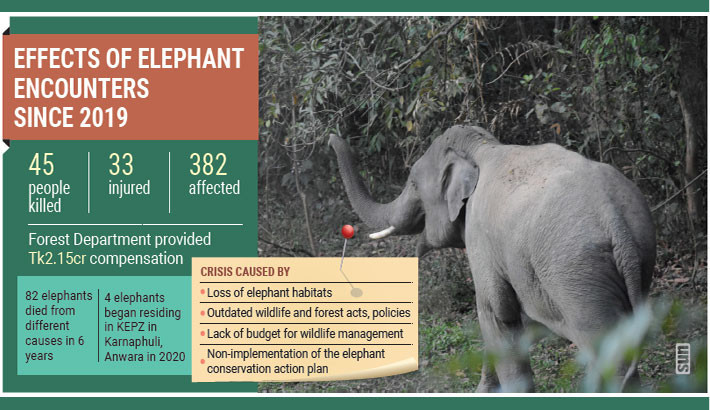Human-elephant conflict continues amid insufficient wildlife management measures
Nur Uddin Alamgir, Chattogram
Published: 13 Mar 2025

The conflict between humans and wild elephants continues claiming human lives and causing significant damages to properties in Chattogram region due to lack of effective wildlife management and conservation efforts.
The death toll of the largest living land mammal is also rising for various human resistances and natural causes.
Experts and conservationists attribute the crisis to deforestation, loss of elephant habitats, outdated wildlife and forest acts and policies, lack of budget for wildlife management, and non-implementation of the elephant conservation action plan.
They laid emphasis on comprehensive survey on elephant population and habitat, proper steps to keep their corridor and habitat uninterrupted, stronger conservation measures, strengthening the wildlife conservation department and updating the necessary acts and policy to create a congenial environment for the mammals.
According to the last census conducted in 2016, there were 268 wild elephants, most of which were in Chattogram region.
In over six years since 2019, at least 45 people have been killed, 33 injured and 382 affected by elephant encounters in this region.
During the period, the Forest Department provided compensation of around Tk2.15 crore for the casualties and damages to crops and properties.
Meanwhile, 82 elephants have been killed or died of different causes during the period, with the highest number recorded in 2020.
The major causes of elephant mortality include illness, electrocution, falling off hills and poisoning, according to the Wildlife Management and Nature Conservation Division (WMNCD), Chattogram.
Concerned sources report that some 35-40 elephants live at three Chattogram upazilas including Anwara, Karnaphuli and Banshkhali.
They roam a huge path through the 15 kilometre corridor from Chunati (Lohagara) Wildlife Sanctuary to Banshkhali Eco Park.
The elephants venture into locality in search of food, leading to casualty and destruction of crops and structures.
The conflict has worsened since four elephants began residing permanently in the Korean Export Processing Zone (KEPZ) located in Karnaphuli and Anwara upazilas in 2020.
The elephants attack people and damage properties often, prompting the KEPZ authority to repeatedly urge the Forest Department and the district administration to relocate them.
Expert committee makes short, mid and long-term recommendations
In response to the escalating crisis, the Ministry of Environment, Forest and Climate Change formed a committee headed by the Chattogram deputy commissioner in October last year.
In a report prepared in light of their observations, the committee suggested short, mid and long-term interventions to address the human-elephant conflict.
The elephants come from other places regularly using certain routes; so if the translocation is made as per the KEPZ authority’s desire, the animals may return again. Meanwhile, study reveals that the translocation may result in intensification in the conflict and increased elephant mortality, the report said.
They rather emphasised on co-existence, offering a more comfortable environment for the gentle giants.
As short-term interventions, the committee suggested restricting access to onlookers to prevent disturbance to elephants, assessment of the elephant movement pattern and mapping, installation of watch tower, installation of early warning system, formation of Elephant Response Team (ERT), awareness raising programme and stopping cutting hills.
The suggested mid-term interventions include thorough survey in and around the conflicting area, and on status of the fodder species within KEPZ and other adjacent areas, fodder plantation and collaring elephants with GPS or radio trackers.
Besides, the long-term interventions include feasibility study for connectivity-corridor establishment, connecting the KEPZ with nearby wildlife sanctuary and fencing around the KEPZ and the community areas.
The committee member secretary, Chattogram Divisional Forest Officer (DFO) Abu Naser Mohammad Yasin Newaj of the (WMNCD) acknowledged that human-elephant conflicts are largely driven by deforestation and corridor destruction.
He noted that while some initiatives have been taken – such as training some 100 KEPZ security guards on managing elephants and forming five ERTs with 50 members from the community – wildlife conservation efforts face budgetary constraints.
There is no revenue budget for wildlife management, Newaj stated, adding that the Elephant Conservation Action Plan will expire in 2027, but large-scale implementation has yet to begin.

